
Amateur telescope making is the activity of building telescopes as a hobby, as opposed to being a paid professional. Amateur telescope makers build their instruments for personal enjoyment of a technical challenge, as a way to obtain an inexpensive or personally customized telescope, or as a research tool in the field of astronomy. Amateur telescope makers are usually a sub-group in the field of amateur astronomy.

Yerkes Observatory is an astronomical observatory located in Williams Bay, Wisconsin, U.S.A. It was operated by the University of Chicago Department of Astronomy and Astrophysics from its founding in 1897 to 2020. Ownership was transferred to the non-profit Yerkes Future Foundation (YFF) in May 2020.

The Mount Wilson Observatory (MWO) is an astronomical observatory in Los Angeles County, California, United States. The MWO is located on Mount Wilson, a 1,740-metre (5,710-foot) peak in the San Gabriel Mountains near Pasadena, northeast of Los Angeles.

A reflecting telescope is a telescope that uses a single or a combination of curved mirrors that reflect light and form an image. The reflecting telescope was invented in the 17th century by Isaac Newton as an alternative to the refracting telescope which, at that time, was a design that suffered from severe chromatic aberration. Although reflecting telescopes produce other types of optical aberrations, it is a design that allows for very large diameter objectives. Almost all of the major telescopes used in astronomy research are reflectors. Reflecting telescopes come in many design variations and may employ extra optical elements to improve image quality or place the image in a mechanically advantageous position. Since reflecting telescopes use mirrors, the design is sometimes referred to as a catoptric telescope.
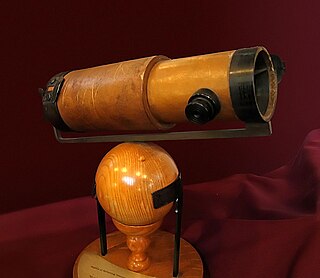
The Newtonian telescope, also called the Newtonian reflector or just the Newtonian, is a type of reflecting telescope invented by the English scientist Sir Isaac Newton (1642–1727), using a concave primary mirror and a flat diagonal secondary mirror. Newton's first reflecting telescope was completed in 1668 and is the earliest known functional reflecting telescope. The Newtonian telescope's simple design has made it very popular with amateur telescope makers.

Boyden Observatory is an astronomical research observatory and science education centre located in Maselspoort, 20 kilometres (12 mi) north-east of the city of Bloemfontein in Free State, South Africa. The observatory is managed by the Physics Department of the University of the Free State (UFS). The Friends of Boyden assist the observatory as a public support group, organising open evenings and protecting its public interest. Boyden also makes use of members of ASSA Bloemfontein Centre, the amateur astronomy club of the city, for presenters and telescope assistants.
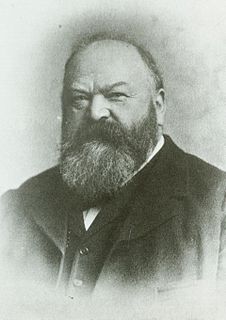
Andrew Ainslie Common FRS (1841–1903) was an English amateur astronomer best known for his pioneering work in astrophotography.
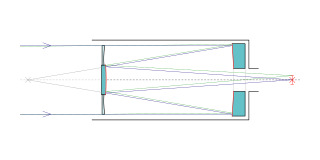
The Schmidt–Cassegrain is a catadioptric telescope that combines a Cassegrain reflector's optical path with a Schmidt corrector plate to make a compact astronomical instrument that uses simple spherical surfaces.

Mount Laguna Observatory (MLO) is an astronomical observatory owned and operated by San Diego State University (SDSU). The telescope was operated in partnership with the University of Illinois at Urbana-Champaign (UIUC) until 2000. MLO is located approximately 75 kilometers (47 mi) east of downtown San Diego, California (USA) on the eastern edge of the Cleveland National Forest in the Laguna Mountains on the SDSU Astronomy Campus near the hamlet of Mount Laguna. MLO was dedicated on June 19, 1968, seven years after SDSU's Department of Astronomy became an independent academic department of SDSU's College of Sciences. The dedication took place during the 1968 summer meeting of the Astronomical Society of the Pacific. Currently SDSU is working with University of Kansas (KU), and UNC Chapel Hill on various projects.

Stull Observatory is an astronomical observatory owned and operated by Alfred University. Named after Dr. John Stull, who helped establish the observatory in 1966, it is located in Alfred, New York (USA). It is notable for housing seven independently housed telescopes ranging in size from 8 to 32 inches. The largest, the Austin-Fellows 32 inch Newtonian Reflector is tied with the Vassar College Class of 1951 Observatory for the rank of second largest optical telescope in New York state after the 40 inch telescope at SUNY Oneonta College Observatory. Telescopes at the observatory are regularly opened to the public. The observatory is also used for those pursuing a minor in astronomy or a concentration in astrophysics.

C.E.K. Mees Observatory is an astronomical observatory in Bristol, New York, owned and operated by the University of Rochester. The observatory is named after C. E. Kenneth Mees, "in honor of his pioneering work in the development of sensitive photographic emulsions for use in astronomy."
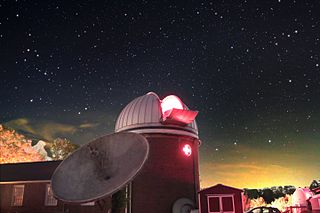
Custer Observatory is an astronomical observatory owned and operated by Custer Institute. Located in Southold, New York (US), facing Peconic Bay and Shelter Island, Custer's location boasts some of the darkest skies on Long Island.

Naylor Observatory is an astronomical observatory owned and operated by Astronomical Society of Harrisburg. It is located near Lewisberry, Pennsylvania, United States.
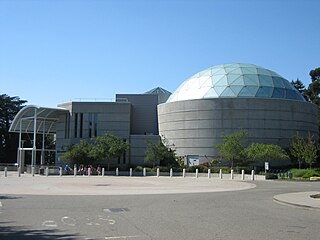
Chabot Space and Science Center, located in Oakland, California, is a center for science learning featuring interactive exhibits, planetariums, a large screen theater, hands-on activities and three powerful telescopes.

J A Jones Hoober Observatory is a privately owned observatory located in South Yorkshire, England near to the villages of Hoober and Wentworth, 4 miles (6.4 km) North-northwest of Rotherham. It can be found about 300 metres (0.19 mi) east of Hoober Stand. The observatory is owned and operated by Mexborough & Swinton Astronomical Society (NPO).

The Hector J. Robinson Observatory is an astronomical observatory in Lincoln Park, Michigan. It houses a 14-inch (360 mm) Celestron SCT. It went back into operation in September 2009. First light ceremonies happened in early September.

The Orchard Hill Observatory is an astronomical observatory located at the highest point on the University of Massachusetts Amherst campus. Constructed in 1965, the observatory is a red brick building with a 16-inch Cassegrain reflector optical telescope. It is used for several community events and is regularly open for public viewing on Thursday nights. Originally the observatory was home to a 20” telescope, given to the department by an avid amateur who lived in central Massachusetts. It was a 1/10 scale model (loosely) of a larger 200” scope. Eventually, a crack was spotted during one of the re-aluminizings of the 20” mirror and the scope was no more. In the meantime, the department had been granted money associated with its move from Hasbrouck to the Grad Research Tower to buy a small telescope and put in on top of the GRC. The GRC had a small "isolation" pad built on its roof, which was supposed to be a mount for the scope, which could be accessed via a small open elevator. However, the GRC had terrible noise and gross vibration problems. The isolation pad never worked and there were too many safety concerns about using the roof of the building for observing. A 16" telescope was later bought from Competition Associates. That scope arrived in 1976 but because of the problems with using the top of the GRC, the scope was never mounted there. In fact, it sat in the basement of Hasbrouck for perhaps 10 years, becoming known as the "Subterranean Telescope.” This situation finally led to the 20" being disassembled and the 16" scope being moved to Orchard Hill and installed in the dome there. The 16" was a major improvement in usability. As to what happened to the 20", the mirror may have been stored in the Astronomy Research Facility but the drive was most likely not kept.
Mount Burnett Observatory is an astronomical observatory in Mount Burnett, Victoria, Australia. It was the main astronomical observatory for the School of Physics at Monash University from the early 1970s. The original telescope was a 16-inch Newtonian reflector built by Mr L. Jeffree of Bendigo. Observers' quarters were built in 1975 with the aid of a grant from the William Buckland Foundation. A 10-inch Newtonian reflector was added, in a separate structure, in the early 1980s, and in 1985 the 16-inch telescope was replaced with a 0.45-meter Newtonian/Cassegrain telescope.

The Dark Sky Observatory (DSO) is an astronomical observatory owned and operated by Appalachian State University (ASU). It is located 9 kilometers (5.6 mi) east of Deep Gap, North Carolina (USA), off of the Blue Ridge Parkway, and 32 kilometers (20 mi) east of the ASU campus in Boone, North Carolina It was established in 1981, and is used for research, instruction, and public viewing events. The Cline Visitors' Center was completed in 2011.














